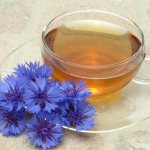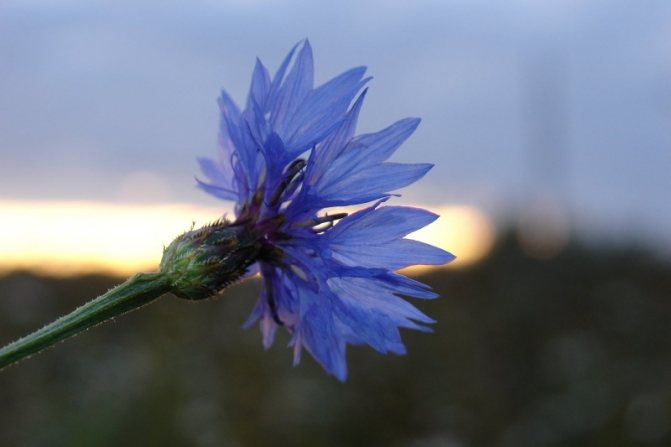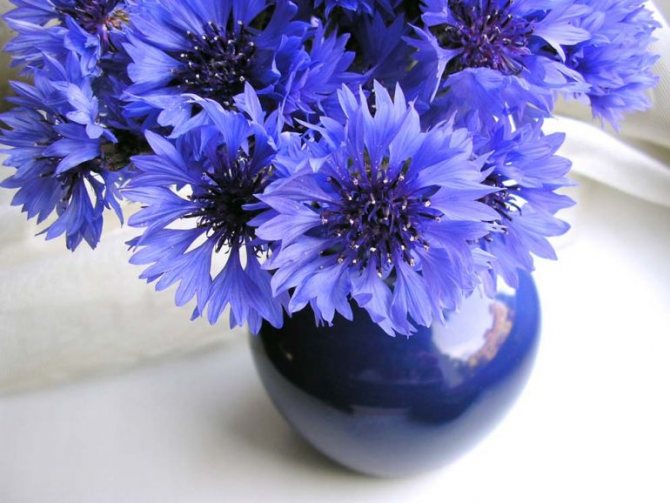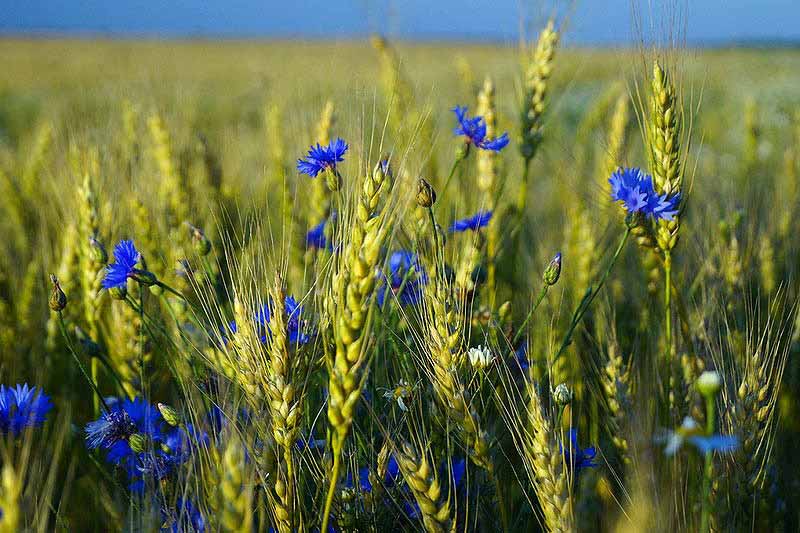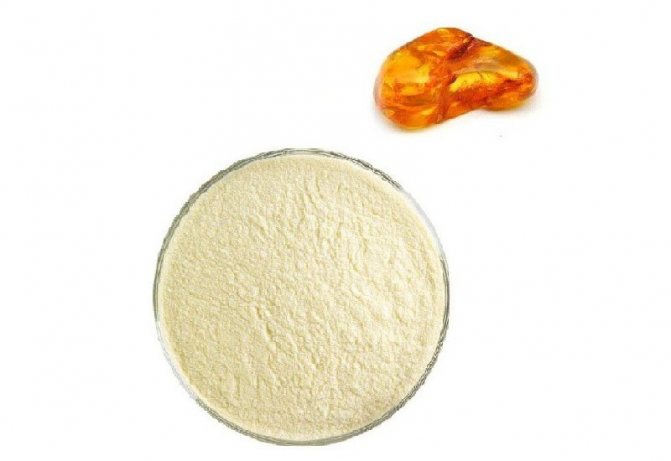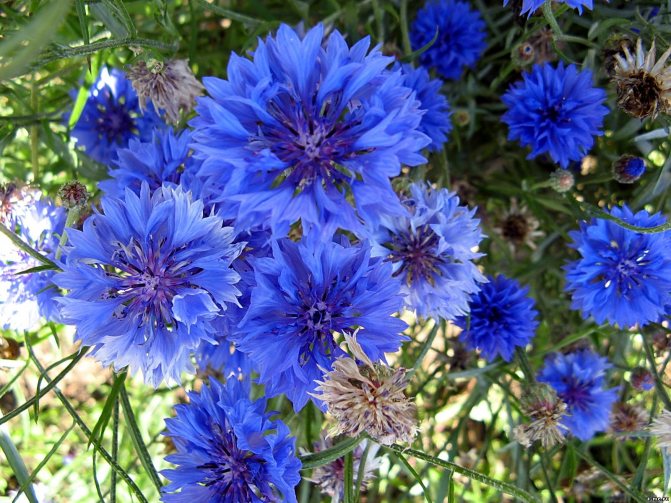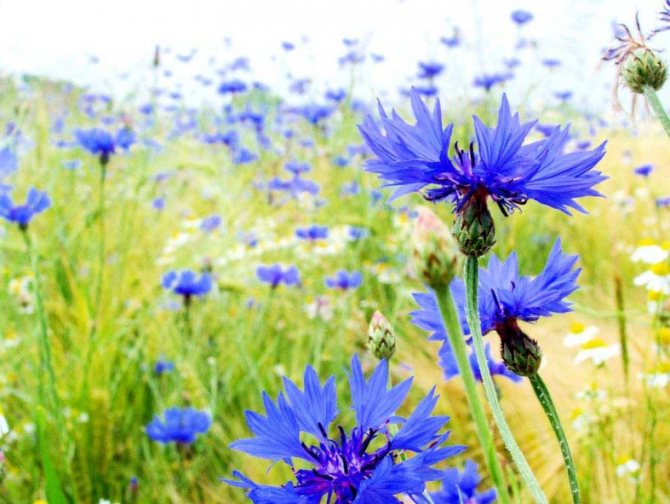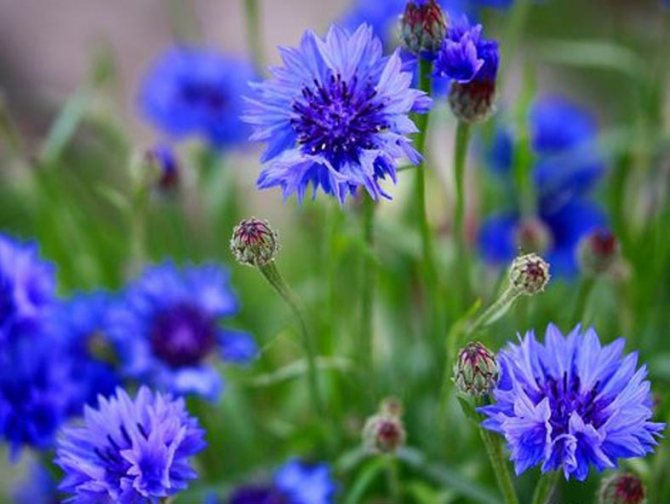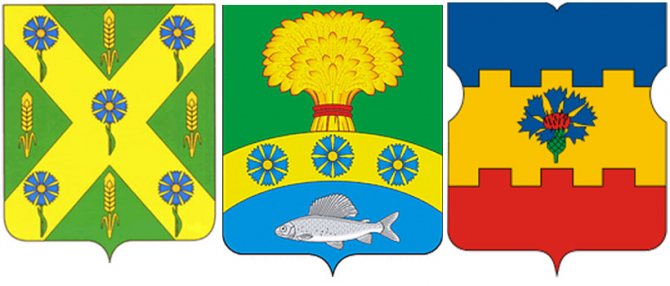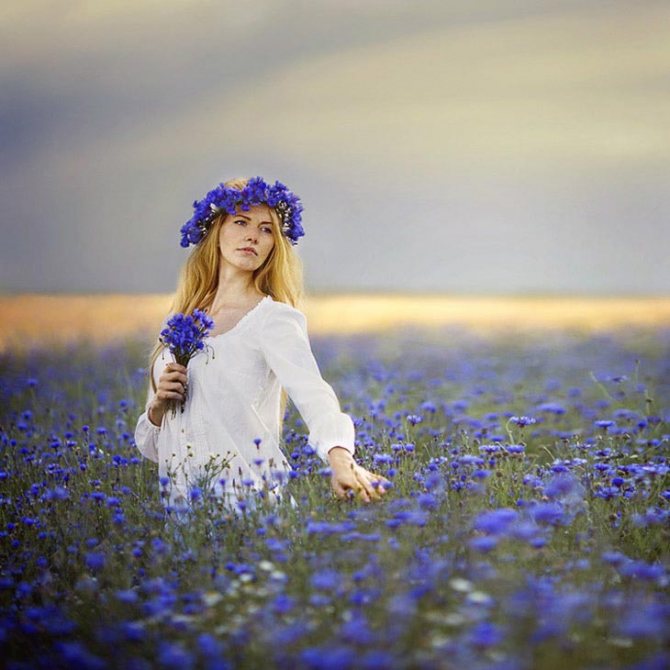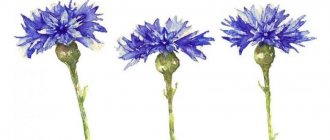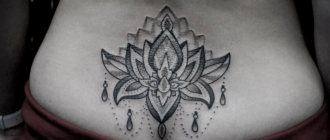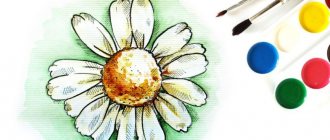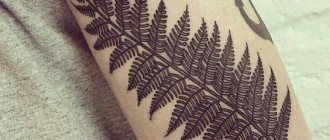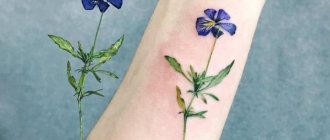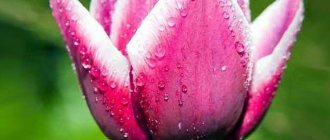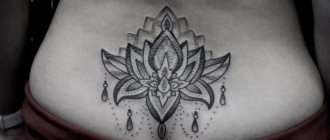What does the flower symbolizes?
If we are guided by the common "language of flowers", the cornflower symbolizes grace. Therefore, the plant is actively added to the wedding bouquet, emphasizing the slender figure of the bride.
In different countries around the world have their own idea of cornflower. In Germany, the flower represents the typical German views in society. For Belgians, the cornflower is a symbol of freedom. And the plant is still revered by Belgians to this day. But the French consider the flower a symbol of anti-Semitism.
In Ukraine, they weave a wreath and include cornflowers in it. Then they put it on the prettiest girl. This is how they celebrate the end of the harvest (the feast of roozhinka).

Tattoo Meaning for Girls
For a woman, the cornflower tattoo is a good choice. The flower indicates that the girl is capable of sincere love, she is faithful and pure. The lady has an open temper, inner harmony and strength, does not give in to the difficulties of life. Such a girl will reciprocate feelings, but will require respect for herself. She has a tolerant character, but is not devoid of inner fire and strength.
The woman with the cornflower tattoo values family ties, dreams of a large family and aims for a strong, serious marriage in which spouses respect each other and are allies.
Beliefs and legends associated with the plant
If you believe the horoscope, cornflowers are best suited to Aries and Sagittarius. There are many legends and beliefs associated with these flowers, some of which are still revered today.
- A Slavic legend. Once upon a time, there lived a beautiful young man, Vasil, who charmed a sensual mermaid with his appearance. One day she decided to confess her love to the boy and even invited him to her unusual underwater world. But the proud Vasil rejected the mermaid's proposal, making her very angry. Rejected and unhappy person turned the young man into a flower blue, resembling the shade of water.
- Greek Mythology. Hercules, during the battle with the hydra, was wounded. Only the centaur Chiron was able to save the dying hero by making a healing remedy out of cornflower. Therefore, for many people the cornflower is a symbol of the fight against many ailments. Folk remedies made from this plant are considered an alternative to modern medicines.
- In magic. But people who practice all kinds of rituals and ceremonies consider cornflower a symbol of protection against evil spirits and demons. That is why the flower has long been used to create special amulets. It is believed that they help to protect a person from the influence of the evil eye and spoilage, among other things. In addition, cornflower is used in love spells. There is a belief that the flower attracts human feelings. In particular, love.
- The legend of Cyanus. A young boy once saw a beautiful flower. Cianus fell so in love with it that he never parted with it. When people found his body, it was studded with flowers. They became known as cyanus, which means "blue."
Because of the differences in stories and legends, there is no one interpretation of what exactly the cornflower symbolizes. For some it is a symbol of love, someone associates with it the separation, and some still make a special amulet out of the flower.
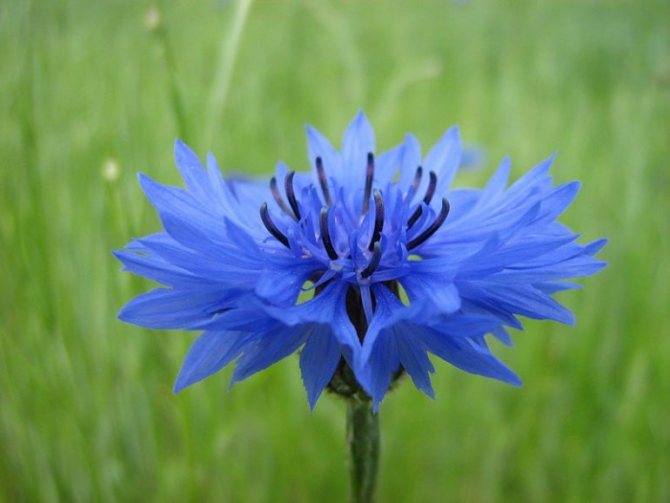

Florists make wonderful flower compositions, combining cenacle (cornflowers) with various plants. Such bouquets will be a wonderful present for the most dear and valued person!
Share
Folk recipes
To relieve inflammation and in the fight against cystitis herbalists offer an effective infusion made from 2 tsp. dried cornflower and a glass of boiling water. Insist the ingredients for about 2 hours and after straining consume 50 ml for 25 minutes before a meal four times a day. With diseases of the eyes will help cornflower decoction, which is prepared from 3 tbsp. dried inflorescences of cinquefoil and 250 ml. water. Combine the components and bring to a boil, then infuse for 2 hours and use as a lotions. Soak cotton pads in the decoction and apply to the eyelids for a quarter of an hour, repeating the procedure up to 3 times a day.
Cornflower: what does the plant tell us?


Today we are talking about flowers, but not all, just one - the cornflower. What secret meaning does it carry and what lies behind its beautiful appearance?
Giving flowers is a beautiful and wonderful tradition that has reached us from ancient times. Now few people know the symbolism of flowers. And in the 18th and 19th centuries it was possible to express the whole range of feelings from all-consuming love to burning hatred with the help of these elegant and beautiful plants.
Young people of the Pushkin century with interest were reading dictionaries and books about the meaning of plants, giving flowers and bouquets of them, investing with this a special and even secret, secret meaning.


The way of passing information through flowers was called the "language of flowers. It is considered that this unusual method of transferring emotions and feelings arose in the Eastern countries, where Muslim women and girls could not openly express their feelings.
Nowadays, the "language of flowers" is not as popular as it was before, and few people know the true meaning of flowers, their secret meaning. But, nevertheless, every year interest in such an original method of transferring feelings is increasing and gaining popularity.
Useful properties
The flower has long been used for medicinal purposes. It contains many substances valuable for human health. In the chemical composition are found:
- Mineral salts of potassium, magnesium, manganese, iron, calcium, copper, chromium, cobalt, vanadium, selenium, boron;
- Vitamin C;
- Coumarins;
- Glycosides;
- Bitterness;
- Tannins;
- Phenolic compounds;
- Anthocyanins;
- Saponins;
- Flavonoids;
- Essential oil.
Flavonoids (primarily anthocyanins), coumarins - compounds with antioxidant properties. Neutralize the effect of free radicals.
Manganese and magnesium have a positive effect on the functioning of the nervous system.
Ascorbic acid or vitamin C - a vitamin responsible for resistance to infections. It participates in the processes of hematopoiesis, the synthesis of collagen. Activates the activity of the endocrine glands.
Coumarins help to reduce blood clotting.
Magic properties of cornflower and rituals of the Slavs
Cornflower is a surprisingly resilient flower. It is not afraid of frosts and drought, it is difficult to kill it even if you really want to. However, our ancestors did not try to do this. On the contrary, after long observation they came to a surprising conclusion: when the rye field is abundantly decorated with blue flowers, the grain harvest will be rich. It is clear that the magical properties of cornflower were used by the Slavs for their own good. And there were two rituals for this purpose.
The first ritual
The first was performed when the first ears of rye first appeared in the field. The youngest daughter was fancy-dressed and plaited with cornflowers and bright blue ribbons and then she was carried into the fields in her arms. The young "priestess" had to pick a few spikes which were then carefully kept in the red corner of the house until the harvest.
The second ritual
The second ritual was performed in the fall. The very first sheaf was decorated with blue flowers, brought to the village and bowed to it with bread and salt.
Cornflower meadow (blue)
The symbolism of this plant is primarily related to the presence of spurs in its flowers. Cornflower blue (Centaurea cyanus) - an annual of the family Asteraceae, a plant with an erect stem up to 80 cm high and alternate, gray-green, spider-like hairy leaves. In towns, starting in the second half of summer, bunches of blue cornflowers are often found at flower vendors - they are eagerly purchased by those attracted to the discreet beauty of the flowers of this plant.
In Christian symbolism, slugs were associated with the devil, and the cornflower, as protection from the devil, with the Virgin Mary and Christ. The vaulted ceiling of this church depicts several hundred species of plants - among them the cornflower. And modern decorators often decorate items of clothing, curtains, towels, napkins with the cornflower pattern. On it the double-headed eagle as an attribute of the Habsburg dynasty and the coat of arms are surrounded by various plants, among which the cornflower stands out.
Since ancient times, the cornflower has delighted people by giving them modest, discreet and lovely flowers. Even in the tomb of Tutankhamen among the untold wealth, archaeologists found a wreath of cornflowers. Flora, the goddess of flowers, spring and youth, was angry at him for neglecting the other colors that she so generously endowed the flowers and trees, and turned him into a blue flower - cornflower. Cornflower blue is a medicinal plant. Pack dried flowers in cotton bags and store in a dark place - in the light cornflower flowers turn white and lose their healing properties.
Neither the ancient Egyptians nor the ancient Greeks knew anything about cornflower. Beginning with Pliny the Elder, there are the first indications of the use of cornflower for wreaths. Tender, sky-blue flower accompanied a man in the fields of rye and wheat, it was dedicated legends, it decorated the holidays. Blue cornflowerC. The genus Centaurea is very large and has more than 800 species worldwide. It can be called a cosmopolitan plant, because it occurs almost on all continents.
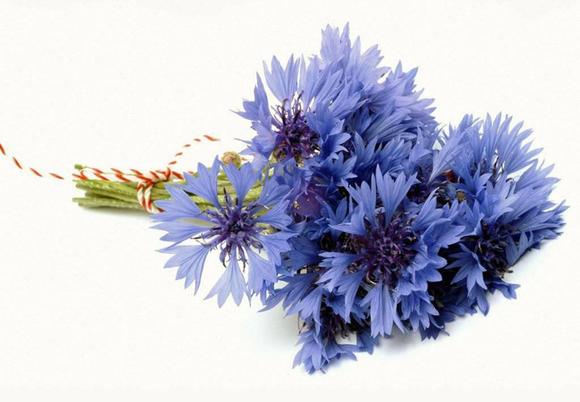

Cornflower in cosmetology
If due to frequent coloring you have damaged the inner structure of the hair, you can rub a hot infusion of cornflower flowers and vinegar. To do this:
- Pour two tablespoons of 6 percent vinegar into a glass of hot water;
- Add one tablespoon of dried cornflower flowers;
- Infuse for at least 20 minutes;
- strain the solution;
- The resulting liquid, pre-heated, rub into the scalp.
Do this daily until the structure of the hair improves.
Decoction of cornflower flowers is used for tired eyes. Swabs soaked in the warm infusion are placed on the eyes. Thanks to him, the eyes are so strengthened that soon you will not need glasses. Redness and bags under the eyes disappear.
Some interpretations from the language of flowers
Aquilegia is a perennial herbaceous plant of the buttercup family (Ranunculaceae), widely distributed in the temperate latitudes of the Northern Hemisphere. Over time, many hybrid forms have also appeared in culture, the common name of which is now A. hybrida.
The plant is poisonous because of the presence in its tissues of a cyanogenic glycoside and is used in homeopathy. The scientific name of the plant is Aquilegia, derived from the Latin words aqua - water and legere - to collect. The ancient Greeks and Romans associated spurgeons with the phallus, and therefore they considered it a plant of the goddess Aphrodite (for the Greeks) or Venus (for the Romans).
Legend has it that this flower was named "blue" (cyanus) after a handsome young man who loved the flower so much that he always wore cornflower garlands and wreaths. In particular, tinctures and decoction of cornflower blue - for colds, dropsy, inflammation of the kidneys. It is also an effective choleretic and antispasmodic agent.
